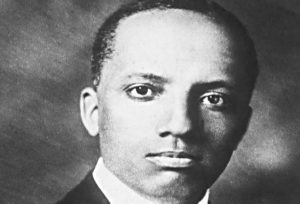

This is how February became Black History Month

It was in 1964 when the author James Baldwin reflected on the shortcomings of his education. “When I was going to school,” he said, “I began to be bugged by the teaching of American history because it seemed that that history had been taught without cognizance of my presence.”
Baldwin’s thoughts echoed those of many before and after him. Half a century earlier, when Carter G. Woodson had the same frustration, he set the foundation for what would become today’s national Black History Month, observed each February.
same frustration, he set the foundation for what would become today’s national Black History Month, observed each February.
In the early 20th century, while he earned a Masters degree from the University of Chicago and a Ph.D. from Harvard, both in history, Woodson witnessed how black people were underrepresented in the books and conversations that shaped the study of American history. According to the way many historians taught the nation’s past, African Americans were barely part of the story—a narrative that Woodson knew was not true. So in 1915, he and Jesse E. Moorland founded the Association for the Study of Negro Life and History (now the Association for the Study of African American Life and History, or the ASALH). The organization would promote studying black history as a discipline and celebrate the accomplishments of African Americans.
“If a race has no history, it has no worthwhile tradition, it becomes a negligible factor in the thought of the world, and it stands in danger of being exterminated,” Woodson said of the need for such study.
In 1926, Woodson and the ASALH launched a “Negro History Week” to bring attention to his mission and help school systems coordinate their focus on the topic. Woodson chose the second week in February, as it encompassed both Frederick Douglass’ birthday on February 14 and Abraham Lincoln’s birthday on February 12.
The celebrations and studies spread quickly, as the ASALH tells it, driving demand for teaching materials and spurring the formation of black history clubs. But, though a newfound understanding of black culture and literature was spreading amongst the middle class, the idea of expanding the week to a month did not come until several decades later. During the Civil Rights Movement, Freedom Schools in the South embraced the week and its curriculum message as a way to contribute to the mission. By the mid-1960s, the most popular textbook for eighth-grade U.S. history classes mentioned only two black people in the entire century of history that had transpired since the Civil War—and that problem could no longer be ignored. It was in that decade that colleges and universities across the country transformed the week into a Black History Month on campus.
A number of mayors had already adopted the celebration as a municipal event by the time President Gerald Ford decreed Black History Month a national observance in 1976, on both the fiftieth anniversary of the first iteration and America’s bicentennial year.
“In celebrating Black History Month,” Ford said in his message, “we can seize the opportunity to honor the too-often neglected accomplishments of black Americans in every area of endeavor throughout our history.”
Presidents have issued national decrees with each year’s theme since the 1970s. African American History Month’s 2016 theme is “Hallowed Grounds: Sites of African American Memories.”
“If a race has no history, if it has no worthwhile tradition, it becomes a negligible factor in the thought of the world, and it stands in danger of being exterminated.”
– Dr. Carter G. Woodson

Insulation & Machine Crew



| Greg Winer 2/3/1997 | Jose Bahena 2/4/2013 |
| Kim Rymer 2/7/2002 | Eric Pearce 2/16/2018 |
| John Rymer 2/5/2004 | Orville Cupit 2/7/2019 |
| Mike Barfield 2/23/2004 | Raimund Chandler 2/10/2020 |
| Randy Smith 2/14/2008 | Jeffrey Bauer 2/17/2020 |
| Rafael Ramirez 2/27/2012 | Stoney Driver 2/17/2020 |
| Brad Parsons 2/1/2013 | Juan Rios 2/18/2020 |
| Brent Parsons 2/1/2013 | Josh Sweeden 2/27/2020 |

Your hard work & dedication are vital to the success of our company.
Thank you for the wonderful years of service!
 February is all about YOUR heart!
February is all about YOUR heart!

Know Your Risk for High Blood Pressure
Risk factors that can increase your risk of high blood pressure include health conditions, your lifestyle, and your family history.
Some of the risk factors for high blood pressure cannot be controlled, such as your age or family history. But you can take steps to lower your risk by changing the factors you can control.
Prevent High Blood Pressure
By living a healthy lifestyle, you can help keep your blood pressure in a healthy range. Preventing high blood pressure, which is also called hypertension, can lower your risk for heart disease and stroke. Practice the following healthy living habits:
Eat A Healthy Diet
Choose healthy meal and snack options to help you avoid high blood pressure and its complications. Be sure to eat plenty of fresh fruits and vegetables.
Talk with your health care team about eating a variety of foods rich in potassium, fiber, and protein and lower in salt (sodium) and saturated fat. For many people, making these healthy changes can help keep blood pressure low and protect against heart disease and stroke.
The DASH (Dietary Approaches to Stop Hypertension) eating plan is a healthy diet plan with a proven record of helping people lower their blood pressure.
Visit the CDC’s Nutrition, Physical Activity, and Obesity website to learn more about healthy eating and nutrition.
Keep Yourself at a Healthy Weight
Having overweight or obesity increases your risk for high blood pressure. To determine whether your weight is in a healthy range, doctors often calculate your body mass index (BMI). If you know your weight and height, you can calculate your BMI at CDC’s Assessing Your Weight website. Doctors sometimes also use waist and hip measurements to assess body fat.
Talk with your health care team about ways to reach a healthy weight, including choosing healthy foods and getting regular physical activity.
Be Physically Active
Physical activity can help keep you at a healthy weight and lower your blood pressure. The Physical Activity Guidelines for Americans recommends that adults get at least 2 hours and 30 minutes of moderate-intensity exercise, such as brisk walking or bicycling, every week. That’s about 30 minutes a day, 5 days a week. Children and adolescents should get 1 hour of physical activity every day.
Visit the website for CDC’s Division of Nutrition, Physical Activity, and Obesity to learn about ways you can be physically active.
Do Not Smoke
Smoking raises your blood pressure and puts you at higher risk for heart attack and stroke. If you do not smoke, do not start. If you do smoke, quitting will lower your risk for heart disease. Your doctor can suggest ways to help you quit.
For more information about tobacco use and quitting, see CDC’s Smoking and Tobacco Use website.
Limit How Much Alcohol You Drink
Do not drink too much alcohol, which can raise your blood pressure. Men should have no more than 2 alcoholic drinks per day, and women should have no more than 1 alcoholic drink per day. Visit the CDC’s Alcohol and Public Health website for more information.
Get Enough Sleep
Getting enough sleep is important to your overall health, and enough sleep is part of keeping your heart and blood vessels healthy. Not getting enough sleep on a regular basis is linked to an increased risk of heart disease, high blood pressure, and stroke.2 Visit CDC’s Sleep and Sleep Disorders website for resources on how to get better sleep.
References
- National Heart, Lung, and Blood Institute. Your Guide to Lowering Your Blood Pressure With DASH pdf. NIH Pub. No. 06-4082. Bethesda, MD: National Heart, Lung, and Blood Institute; 2006.
- National Heart, Lung, and Blood Institute. Sleep Deprivation and Deficiency. (2019). https://www.nhlbi.nih.gov/health-topics/sleep-deprivation-and-deficiency. Accessed October 7, 2019.

Richar Atencio, Bailey Eastep, Cody Hammonds, Laiton Hill,
Jonathan Hurd, Delbert Roberts & Maximo Zalazar

